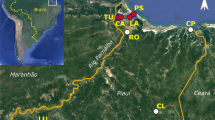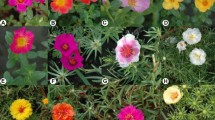Abstract
Hedychium spicatum, a perennial rhizomatous medicinal plant distributed in subtropical and temperate parts, is considered nearly endemic to the Himalayan region.In this study allozyme markers were utilized to assess genetic variations and relationships among 12 distinct populations of this species from the West Himalaya of India. A high level of genetic diversity was found among the populations. Of the 13 loci generated using eight enzymes, 12 (92%) were polymorphic. F-statistics suggested a prevalence of a high heterozygote excess among populations (F IS = –0.51). Gene flow estimates and geographic distances between populations did not correlate significantly (r = –0.0258, P < 0.3550). The excess heterozygosity may be attributed to high pollinator mobility and inbreeding coefficient within the subpopulation, relative to the total F IS value. High frequencies of several alleles at different loci probably reflect the breeding pattern, as the species propagates clonally as well as through seeds. We also discuss conservation implications for the target species.


Similar content being viewed by others
References
Bisht GS, Awasthi AK, Dhole TN (2006) Antimicrobial activity of Hedychium spicatum. Fitoter 77:240–242
Bohonak AJ (2002) Antimicrobial activity of Hedychium spicatum. J Hered 93:153–154
Bouza N, Caujape CJ, Gonza lez-Perez MA, Batista F, Sosa PA (2002) Population structure and genetic diversity of two endangered endemic species of the Canarian laurel forest: Dorycnium spectabile (Fabaceae) and Isoplexis chalcantha (Scrophulariaceae). Int J Plant Sci 163:619–630
Chopra RN, Nayar SL, Chopra LC (1986) Glossary of Indian medicinal plants. CSIR, New Delhi, pp 130–131
Eguiarte LE, Perez-Nasser N, Piñero D (1992) Genetic structure, out-crossing rate and heterosis in Astrocaryum mexicanum (tropical palm): implications for evolution and conservation. Heredity 69:217–228
Ellstrand NC, Elam DR (1993) Population genetic consequences of small population size: implications for plant conservation. Annu Rev Eco Syst 24:217–242
Francisco-Ortega J, Santos-Guerra A, Kim SC, Crawford DJ (2000) Plant genetic diversity in the Canary Islands: a conservation perspective. Am J Bot 87:909–919
Frankham R (1995) Conservation genetics. Ann Rev Genet 29:305–327
Frankham R, Ballou JD, Briscoe DA (2002) Introduction to conservation genetics. Cambridge University Press, Cambridge
Gottlieb LD (1977) Electrophoretic evidence and plant systematics. Ann Mo Bot Gard
Hamrick JL, Godt MJW (1989) Allozyme diversity in plant species. In: Brown AHD, Clegg MT, Kahler AL, Weir BS (eds) Plant population genetics, breeding and genetic resources. Sinauer Associates, Sunderland, pp 43–63
Hamrick JL, Godt MJW (1996) Effect of life history traits on genetic diversity in plant species. Philos Trans Roy Soc Lond B (Biol Sci) 351:1291–1298
Hamrick JL, Godt MJW, Sherman-Broyles SL (1992) Factors influencing levels of genetic diversity in woody plant species. New For 6:95–124
Huh MK, Chung SD, Huh HW (1998) Allozyme variation and population structure of Pyrola japonica in Korea. Bot Bull Acad Sin 39:107–112
Joshi S, Chanotiya CS, Agarwal G, Prakesh O, Pant AK, Methela CS (2008) Terpenoide compositions and antioxidant and antimicrobial properties of the rhizome essential oil of different Hedychium species. Chem Biodivers 5:299–309
Kimura M, Crow JF (1964) The number of alleles that can be maintained in a finite population. Genetics 49:725–738
Mantel NA (1967) The detection of disease clustering and a generalized regression approach. Cancer Res 27:209–220
Miller MP (1997) Tools for population genetic analyses (TFPGA) 1.3: a Windows program for the analysis of allozyme and molecular population genetic data. Distributed by author
Nei M (1972) Genetic distance between populations. Am Nat 106:283–292
Nei M (1978) Estimation of average heterozygosity and distance from a small number of individuals. Genetics 89:583–590
Nei M (1987) Molecular evolutionary genetics. Columbia University Press, New York
Peakall R, Smouse PE (2006) Genalex 6: genetic analysis in excel. Population genetic software for teaching and research. Mol Ecol Notes 6:288–295
Rajora OP (1988) Allozymes for identification and differentiation of some Populus maximowiczii Henry clonal varieties. Biochem Syst Evol 16:635–640
Samant SS, Pant S (2006) Diversity, distribution pattern and conservation status of the plants used in liver disease ailments in Indian Himalayan region. J Mt Sci 3:28–47
Samant SS, Dhar U, Palni LMS (1998) Medicinal plants of Indian Himalaya: diversity, distribution potential values. Himavikas, Gyanodaya Prakashan, Nainital, publ. 13
Sampson JF, Hopper SD, Jones SH (1988) Genetic diversity and the conservation of Eucalyptus crucis maiden. Aust J Bot 36:447–460
Slatkin M (1987) Gene flow and the geographic structure of natural populations. Science 236:787–792
Slatkin M (1993) Isolation by distance in equilibrium and nonequilibrium populations. Evolution 47:264–279
Sokal RR, Rohlf FJ (1981) Biometry, 2nd edn. Freeman, New York
Soltis DE, Haufler CH, Darrow DC, Gastony GJ (1983) Starch gel electrophoresis of ferns: a compilation of grinding buffers, gel and electrode buffer, and staining schedules. Am Fern J 73:9–27
Sosa PA (2001) Genes, poblaciones y especies. In: Martin-Esquivel J, Fernandez-Palacios JM (eds) Naturaleza de las Islas Canarias. Santa Cruz de Tenerife, Editorial Turquesa, Canary Islands, pp 151–155
StatSoft Inc (1985) Statistica for Windows, release 6.0. StatSoft Inc., Tulsa, OK
Sun M (1997) Genetic diversity in three colonizing orchards with contrasting mating systems. Am J Bot 84:224–232
Swofford DL, Olsen GJ (1990) Phylogeny reconstruction. In: Hillis DM, Moritz C (eds) Molecular systematics. Sinaur Associates, Sunderland
Weir BS (1990) Genetic data analysis: methods for discrete population analysis. Sinauer Associates, Sunderland
Wendel JF, Weeden NF (1989) Visualization and interpretation of plant isozymes. In: Soltis DE, Soltis PS (eds) Isozymes in plant biology. Dioscorides Press, Portland, pp 5–45
Wright S (1951) The genetical structure of populations. Ann Eugen 15:323–354
Wright S (1978) Evolution and the genetics of populations, vol. 4: variability within and among natural populations. University of Chicago Press, Chicago
Yeh FC, Yang RC, Boyle TBJ, Ye ZH, Mao JX (1999) PopGene version 1.32. The user-friendly shareware for population genetic analysis. Molecular Biology and Biotechnology Centre, University of Alberta, Canada
Acknowledgments
The authors thank Dr. L. M. S. Palni, Director, GBPIHED, for providing the facilities and encouragement. Thanks are also due to Prof. Pedro Garcia, Universidad de Leon, Spain for the valuable input during experimental design and critical analysis of the data. UD thanks the National Academy of Sciences, India, and Hamdard University, New Delhi, for their support. Financial support from GBPIHED under Project 10 is gratefully acknowledged.
Author information
Authors and Affiliations
Corresponding author
Rights and permissions
About this article
Cite this article
Jugran, A., Bhatt, I.D., Rawat, S. et al. Genetic Diversity and Differentiation in Hedychium spicatum, a Valuable Medicinal Plant of Indian Himalaya. Biochem Genet 49, 806–818 (2011). https://doi.org/10.1007/s10528-011-9451-7
Received:
Accepted:
Published:
Issue Date:
DOI: https://doi.org/10.1007/s10528-011-9451-7




